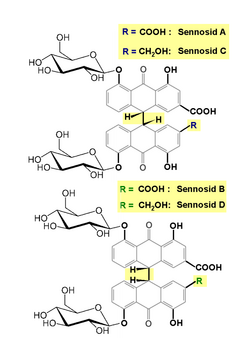Chemistry:Senna glycoside
 | |
| Clinical data | |
|---|---|
| Trade names | Ex-Lax, Senokot, others[1] |
| AHFS/Drugs.com | Monograph |
| MedlinePlus | a601112 |
| License data | |
| Pregnancy category |
|
| Routes of administration | By mouth, rectal |
| ATC code | |
| Legal status | |
| Legal status |
|
| Pharmacokinetic data | |
| Onset of action | Minutes (by rectum), 6 to 12 hours (by mouth)[3] |
| Identifiers | |
| |
| CAS Number | |
| PubChem CID | |
| DrugBank | |
| ChemSpider | |
| KEGG | |
| Chemical and physical data | |
| Formula | C42H38O20[4] |
| Molar mass | 862.746 g·mol−1 |
| | |
Senna glycoside, also known as sennoside or senna, is a medication used to treat constipation and empty the large intestine before surgery.[1][5] The medication is taken by mouth or via the rectum.[1][6] It typically begins working in around 30 minutes when given by rectum and within twelve hours when given by mouth.[3] It is a weaker laxative than bisacodyl and castor oil.[1]
Common side effects of senna glycoside include abdominal cramps.[3] It is not recommended for long-term use, as it may result in poor bowel function or electrolyte problems.[1] While no harm has been found to result from use while breastfeeding, such use is not typically recommended.[1] It is not typically recommended in children.[1] Senna may change urine to a somewhat reddish color.[1] Senna derivatives are a type of stimulant laxative and are of the anthraquinone type.[1] While its mechanism of action is not entirely clear, senna is thought to act by increasing fluid secretion within and contraction of the large intestine.[1]
Sennosides come from the group of plants Senna.[3] In plant form, it has been used at least since the 700s AD.[7] It is on the World Health Organization's List of Essential Medicines.[8] It is available as a generic medication.[1][6] In 2021, it was the 270th most commonly prescribed medication in the United States, with more than 1 million prescriptions.[9][10] In 2021, the combination with docusate was the 275th most commonly prescribed medication in the United States, with more than 800,000 prescriptions.[9][11] It is sold under a number of brand names including Ex-Lax and Senokot.[1]
Medical uses
Senna is used for episodic and chronic constipation though there is a lack of high-quality evidence to support its use for these purposes.[5] It may also be used to aid in the evacuation of the bowel prior to surgery or invasive rectal or colonic examinations.[12][13]
Administration
Oral senna products typically produce a bowel movement in 6 to 12 hours. Rectal suppositories can act within minutes or take up to two hours.[14]
Contraindications
According to Commission E, senna is contraindicated in cases of intestinal obstruction, acute intestinal inflammation (e.g., Crohn's disease), ulcerative colitis, appendicitis, and abdominal pain of unknown origin.[12]
Senna is considered contraindicated in people with a documented allergy to anthraquinones. Such allergies are rare and typically limited to dermatological reactions of redness and itching.[12]
Adverse effects
Adverse effects are typically limited to gastrointestinal reactions and include abdominal pain or cramps, diarrhea, nausea, and vomiting.[12]
Regular use of senna products can lead to a characteristic brown pigmentation of the internal colonic wall seen on colonoscopy. This abnormal pigmentation is known as melanosis coli.[14]
Interactions
Senna glycosides can increase digoxin toxicity in patients taking digoxin by reducing serum potassium levels, thereby enhancing the effects of digoxin.[15]
Mechanism of action
The breakdown products of senna act directly as irritants on the colonic wall to induce fluid secretion and colonic motility.[16]
Pharmacology
They are anthraquinone derivatives and dimeric glycosides.[17]
Society and culture
Formulations
Senna is an over-the-counter medication available in multiple formulations, including oral formations (liquid, tablet, granular) and rectal suppositories. Senna products are manufactured by multiple generic drug makers and sold under various brand names.[13]
Brand names
Ex-Lax, Geri-kot, Perdiem Overnight Relief, Senexon, Pursennid, Senna Smooth, Senna-Gen, Senna-GRX, Senna-Lax, Senna-Tabs, Senna-Time, SennaCon, Senno, Senokot.[12]
References
- ↑ 1.00 1.01 1.02 1.03 1.04 1.05 1.06 1.07 1.08 1.09 1.10 1.11 "Senna". Drugs.com. 1 January 2008. https://www.drugs.com/monograph/senna.html.
- ↑ https://www.tga.gov.au/products/medicines/find-information-about-medicine/prescribing-medicines-pregnancy-database
- ↑ "Senna(Powdered)". PubChem. U.S. National Library of Medicine. https://pubchem.ncbi.nlm.nih.gov/compound/171194.
- ↑ 5.0 5.1 "Constipation: Advances in Diagnosis and Treatment". JAMA 315 (2): 185–91. January 2016. doi:10.1001/jama.2015.16994. PMID 26757467.
- ↑ 6.0 6.1 Tarascon pharmacopoeia (2010 ed.). Sudbury, Mass.: Jones and Bartlett. 2010. p. 181. ISBN 9780763777685. https://books.google.com/books?id=Urmh7ylCXnoC&pg=PA181.
- ↑ Indian Herbal Remedies Rational Western Therapy, Ayurvedic and Other Traditional Usage, Botany. Berlin, Heidelberg: Springer Berlin Heidelberg. 2004. p. 133. ISBN 9783642186592. https://books.google.com/books?id=njLtCAAAQBAJ&pg=PA133.
- ↑ World Health Organization model list of essential medicines: 21st list 2019. Geneva: World Health Organization. 2019. WHO/MVP/EMP/IAU/2019.06. License: CC BY-NC-SA 3.0 IGO.
- ↑ 9.0 9.1 "The Top 300 of 2021". https://clincalc.com/DrugStats/Top300Drugs.aspx.
- ↑ "Sennosides - Drug Usage Statistics". https://clincalc.com/DrugStats/Drugs/Sennosides.
- ↑ "Senna; Docusate - Drug Usage Statistics". https://clincalc.com/DrugStats/Drugs/SennaDocusate.
- ↑ 12.0 12.1 12.2 12.3 12.4 Lexicomp Online, Lexi Drugs Online, Hudson, Ohio: Lexi-Comp, Inc.; 17 April 2014.
- ↑ 13.0 13.1 Drugs.com "Senna (Professional Patient Advice)". https://www.drugs.com/ppa/senna.html.
- ↑ 14.0 14.1 "Chapter 62. Drugs Used in the Treatment of Gastrointestinal Diseases.". Basic & Clinical Pharmacology (12th ed.). New York, NY: McGraw-Hill. 2012. http://accessmedicine.mhmedical.com/content.aspx?bookid=388&Sectionid=45764290. Retrieved 18 April 2014.
- ↑ "Senna: MedlinePlus Supplements". https://www.nlm.nih.gov/medlineplus/druginfo/natural/652.html.
- ↑ "Chapter 46. Treatment of Disorders of Bowel Motility and Water Flux; Anti-Emetics; Agents Used in Biliary and Pancreatic Disease.". Goodman & Gilman's The Pharmacological Basis of Therapeutics (12th ed.). New York, NY: McGraw-Hill. 2011. http://accessmedicine.mhmedical.com/content.aspx?bookid=374&Sectionid=41266256. Retrieved 18 April 2014.
- ↑ "The senna drug and its chemistry". Pharmacology 47 (Suppl. 1): 2–6. October 1993. doi:10.1159/000139654. PMID 8234429.
 |

